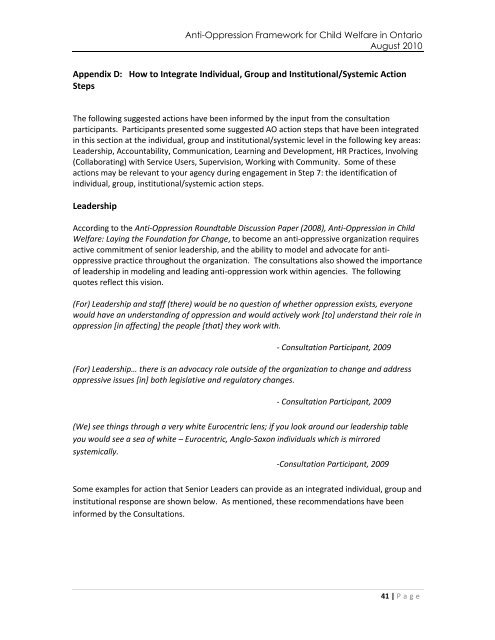An Anti-Oppression Framework for Child Welfare in Ontario
An Anti-Oppression Framework for Child Welfare in Ontario
An Anti-Oppression Framework for Child Welfare in Ontario
Create successful ePaper yourself
Turn your PDF publications into a flip-book with our unique Google optimized e-Paper software.
<strong>An</strong>ti-<strong>Oppression</strong> <strong>Framework</strong> <strong>for</strong> <strong>Child</strong> <strong>Welfare</strong> <strong>in</strong> <strong>Ontario</strong>August 2010Appendix D: How to Integrate Individual, Group and Institutional/Systemic ActionStepsThe follow<strong>in</strong>g suggested actions have been <strong>in</strong><strong>for</strong>med by the <strong>in</strong>put from the consultationparticipants. Participants presented some suggested AO action steps that have been <strong>in</strong>tegrated<strong>in</strong> this section at the <strong>in</strong>dividual, group and <strong>in</strong>stitutional/systemic level <strong>in</strong> the follow<strong>in</strong>g key areas:Leadership, Accountability, Communication, Learn<strong>in</strong>g and Development, HR Practices, Involv<strong>in</strong>g(Collaborat<strong>in</strong>g) with Service Users, Supervision, Work<strong>in</strong>g with Community. Some of theseactions may be relevant to your agency dur<strong>in</strong>g engagement <strong>in</strong> Step 7: the identification of<strong>in</strong>dividual, group, <strong>in</strong>stitutional/systemic action steps.LeadershipAccord<strong>in</strong>g to the <strong>An</strong>ti-<strong>Oppression</strong> Roundtable Discussion Paper (2008), <strong>An</strong>ti-<strong>Oppression</strong> <strong>in</strong> <strong>Child</strong><strong>Welfare</strong>: Lay<strong>in</strong>g the Foundation <strong>for</strong> Change, to become an anti-oppressive organization requiresactive commitment of senior leadership, and the ability to model and advocate <strong>for</strong> antioppressivepractice throughout the organization. The consultations also showed the importanceof leadership <strong>in</strong> model<strong>in</strong>g and lead<strong>in</strong>g anti-oppression work with<strong>in</strong> agencies. The follow<strong>in</strong>gquotes reflect this vision.(For) Leadership and staff (there) would be no question of whether oppression exists, everyonewould have an understand<strong>in</strong>g of oppression and would actively work [to] understand their role <strong>in</strong>oppression [<strong>in</strong> affect<strong>in</strong>g] the people [that] they work with.- Consultation Participant, 2009(For) Leadership… there is an advocacy role outside of the organization to change and addressoppressive issues [<strong>in</strong>] both legislative and regulatory changes.- Consultation Participant, 2009(We) see th<strong>in</strong>gs through a very white Eurocentric lens; if you look around our leadership tableyou would see a sea of white – Eurocentric, <strong>An</strong>glo-Saxon <strong>in</strong>dividuals which is mirroredsystemically.-Consultation Participant, 2009Some examples <strong>for</strong> action that Senior Leaders can provide as an <strong>in</strong>tegrated <strong>in</strong>dividual, group and<strong>in</strong>stitutional response are shown below. As mentioned, these recommendations have been<strong>in</strong><strong>for</strong>med by the Consultations.41 | P a g e
















